Exactly.there is not correct sense of power and correct sense of dynamics.....the sound is clean, clear, flat, full range etc but it still sucks, big time.
LOL, MDR, PTDR, and all that kind of things. So true.This phono cartridge does not sound right until you play 2000 of your favorite LP's on it, oh well now it's time to replace the stylus.
A lot of what people call breaking in is really more the listener getting used to the sound. It is true that some speakers have to be broken in, but typically they are ones with untreated paper surrounds (such as guitar speakers).
T and Rayma, I agree that speaker break-in can be very important, even with expensive speakers. I had a problem with the tweeters in the Sasha speakers that Dave Wilson gave me a few years ago. They were very irritating, compared to my Met 7's (for example, that don't have any highs) and I even complained to Dave Wilson (so much about accepting free speakers without criticism) about it. I thought it would last forever, so I got a pair of super tweeters, tube driven and I hoped to add a inductor in series with the main tweeter to roll it off as necessary. Not too surprisingly, the tweeters (broke in) and now they are not annoying. It just took a hundred hours or less. Now, I rarely use my super tweeters, and have given up on the added inductor. With the BEST sources the Sashas can sound wonderful, (at least enough to me).
T, yes, it would appear that you have fallen for ad and reviewer hype. I am always suspicious of products that 'do too much' being very successful to people who actually know what things actually sound like, like you.
T, yes, it would appear that you have fallen for ad and reviewer hype. I am always suspicious of products that 'do too much' being very successful to people who actually know what things actually sound like, like you.
I have noticed that both JBL and TAD Be compression drivers do take a far bit of time to relax and open up. Initially, they seem almost harsh.
My 2 cents, anyway.
My 2 cents, anyway.
I’d trashed a driver in some new headphones a few years ago by turning up the volume. They didn’t produce the decibels that I thought they should, turned out they were just new and hadn’t loosened up yet. I allowed the next pair to play for some time before trying that again.
I had no idea the difference would be that pronounced.
I had no idea the difference would be that pronounced.
Thanks for the compliment.I had a problem with the tweeters in the Sasha speakers that Dave Wilson gave me a few years ago. They were very irritating, compared to my Met 7's (for example, that don't have any highs)...
T, yes, it would appear that you have fallen for ad and reviewer hype. I am always suspicious of products that 'do too much' being very successful to people who actually know what things actually sound like, like you.
May-i add some comments ?
I have read several times that, with age, we do not like high frequencies as in our young age. An effect of the losses of our hearing ?
When I was young, i was always trying to add some extreme trebles to the cymbals and female voices in my mixs. trying to add sparkling. In the same time, i was always unsatisfied by the result, admiring the way they were sounding in records like "take five" of Dave Brubeck, without being able to get this presence.
Now I know better: if you want to add something to them, it is...basses to add size and a large membrane mic to catch the impact ! they are not so bright, so "hifi" in real life. ;-)
My big system do not have any tweeter. The horn is passively corrected to be as flat as possible between 600 and 15.000Hz, where it cut naturally. I tried too to add an ultrasonic tweeter: catastrophic !!!! (Like you)
In fact, I think we don't need anything upper: there is mainly distortion components. Micro dynamic is not here. (But i'm not young anymore, despite all my attempts, so cannot speak for younger ;-)
An other think. I remember those Audax aluminium tweeters, used by Leon (Elipson) in the 60-70 years. They were flat up to 40KHz. Was young at this time, but always found them awful, "irritating", as you said. As I feel those KEF LS50.
Last edited:
They didn’t produce the decibels that I thought they should, turned out they were just new and hadn’t loosened up yet.
Let me guess, this can't be measured.
After little time listening to various sources with my new Kef LS50 wireless, and after the first surprises to hear what came out of such small speakers, I'm disappointed.
No "body" anywhere, it lacks a base in the low medium, the treble is aggressive, there is a bump in high treble, it sounds distorted, I always want to lower the level, yet far from to be high. But it does not help.
I do not understand the so much praise comments that can be read everywhere.
It may be due to the class D amp, if they are very analytical, they often give the feeling that it lacks "material", the amp class AB in the treble that sounds aggressive (I'm used to current feedback amps)?
Finally, it is expensive for a bar of sound that I just feel good enough to listen to the TV.
No miracle, at the end !
Tournesol,
They sound best when played at comfortable listening levels - They do not excel at low listening volumes - but then I know very, very few speakers where this is the case (in the old days, you had a loudness control and bass/treble which were particularly useful at low listening volumes).
They are compact speakers so they are better suited to small rooms and some rear wall reinforcement can help but a sub-bass works wonders in a larger room which is what I have done and I understand many other owners.
You may need to let them settle a bit for treble to sort itself out. I would have said the treble is particularly good on the LS50's - not aggressive at all and the imaging is outstanding. That said, mine are not the powered version, and I am not a believer in class D. These are not efficient speakers either - about 85 dB IIRC.
Anyway, hope you grow to like them . . . they are British, you are French, sometimes hard to see eye to eye 😀 😉
Last edited:
they just offer ultrasonic performances with no basses ?
The port on the back has 3 options: empty (the most bass, for a larger room); a foam ring insert (for an average room); the foam ring insert with a center insert (the least bass, for a small room). Do you have the inserts installed? If so, I'd remove both of them. However, this speaker is not intended to produce deep bass.
A lot of what people call breaking in is really more the listener getting used to the sound.
Not in this case.
Just long enough for the 30 day return policy to run out.
This is not something that KEF says, but from personal experience.
Not in this case.
Could be. However, source and listener effects can be tricky to fully disentangle. Doesn't have to be all one or the other.
Impossible I'd saysource and listener effects can be tricky to fully disentangle.
And regards long term auditory memory, I wonder how long it is. I listened to an album I hadn't heard in a while the other day, and it sounded quite different to how I remember it, and I know it well. So much of this subjective talk is useless 🙂
Last edited:
Let me guess...
Some offline activity for you, sir. Please make PM inbox accessible.
"I had no idea the difference would be that pronounced"
Or the first 'phones were faulty and the replacements good.
We will never know.
Or the first 'phones were faulty and the replacements good.
We will never know.
My perception is an artificial 'signature' associated with the audio passing through an audio stage, especially my own. When I first make a design, I usually find little wrong, in fact it can sound almost perfect. This started with the Levinson JC-2, 45 years ago. I really thought that I had done enough (and I had done far more than anyone else in solid state at the time) to make the perfect preamp, and I even resisted input from others, when they found some sort of fault with it. However, even my first JC-2 was flawed, almost embarrassingly, thinking back, but then so was the first Porsche 911, etc. Yet my original JC-2 would be sonically better today than most here use for their hi fi, it is just a matter of whether you find audio quality that important to you that you will try for the best quality, rather than good enough.
Max volume, only "class A line driver" in audio path, gain 3.7, rails +-12.6V
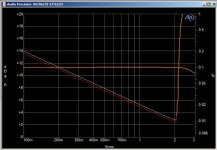
frequency sweep Max volume, input 2Vrms
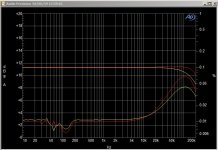
FFT fundamental 1kHz, 1V rms input, 100kOhm load It is clear that in THD+N measurements hum dominates
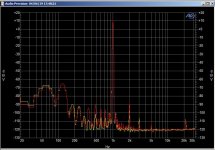
FFT fundamental 1kHz, 1Vrms input, 600 Ohm load, gain 2.7
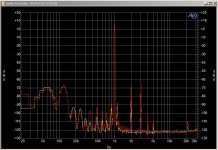
FFT fundamental 1kHz, 500mVrms input, 600 Ohm load, gain 2.7, output current 3mA peak (looks like a limit for "class A line driver")
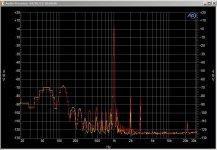
FFT fundamental 10kHz, 1V rms input, 600 Ohm load
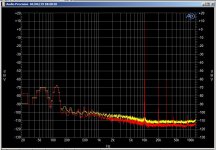
FFT 10kHz fundamental, 100kOhm load, 1V rms input
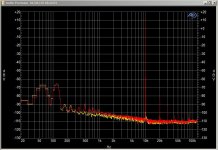
Some offline activity for you, sir. Please make PM inbox accessible.
Sorry should be OK.
- Status
- Not open for further replies.
- Home
- Member Areas
- The Lounge
- John Curl's Blowtorch preamplifier part III